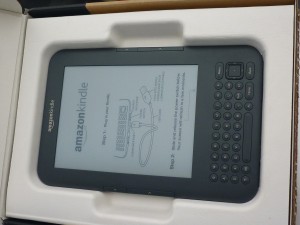Six worldly views on this weeks’s topic of leaner autonomy. Click any thumbnail to view the post.
 Chuck Sandy |
 Anna Loseva |
 Vicky Loras |
 Tamas Lorincz |
 Vladimira Chalyova |
 Matt Shannon |
Six worldly views on this weeks’s topic of leaner autonomy. Click any thumbnail to view the post.
 Chuck Sandy |
 Anna Loseva |
 Vicky Loras |
 Tamas Lorincz |
 Vladimira Chalyova |
 Matt Shannon |
What’s Real Reading? The E-books or Print Books Debate

If you want to start an argument among a room full of reading specialists, ask them what reading is and how best to teach it. The reading wars have been raging for decades, and no one has ever really had a correct answer to these questions even in the pre-digital age when books were books and the printed word was all there was. Now in the digital age, the questions have become enormously complicated. What is reading? What actually happens when we read? Does the brain respond differently to flat words on a printed page than it does to hyperlinked words on a digital platform that lead us to interactive graphs, reader reviews, YouTube Videos, and more? Is reading online really reading? Is Google making us stupid?
Although I have spent the greater part of my professional life trying to figure all this out, what really interests me now is why some people become readers while others will openly tell you that they don’t like reading, or even that they don’t read. As a person who can’t leave the house without a bag full of books and a fully loaded Kindle, I find this hard to understand. What do they mean they don’t read, I wonder, and so I ask them. They usually mean books, particularly the kind of books people read in school or for pleasure. Then I wonder how might it be possible to turn non-readers into readers and since this is such an important thing to do, does it really matter whether new reader read printed books or e-books or band fan sites or hotel reviews on the Internet? It’s all reading, right?

My own position is that somehow it’s all reading and that it doesn’t matter what people read as long as they read, and I’ll tell you why later, but right now I’d like you to read what Christina Markoulaki and Barbara Hoskins Sakamoto have to say about e-books and printed books, and how they approach reading in their classrooms. Then I’d like you to go to http://itdi.pro/ and tell us what you think by posting a comment in the E-Books or Print Books Debate. You’ll find my answer there. You’ll need to log-in to the http://itdi.pro/ site and thenclick on Forums to get there, but that’s pretty easy to do.
From time to time we’ll feature a debate like this one on the iTDi Blog with the hope that you will join in the discussion. Feel free to respond to any of the points Christina and Barbara make in their thoughtful posts or to any of the questions I’ve raised here. Also, we’d love to know more about what you read and how you read it, but more importantly, what and how do your students read?
If you’d like to do a little more, you might like to conduct a reading survey like the one proposed by Katherine Schulten and Shannon Doyne in their New York Times article on the future of reading.
They suggest “keeping a 24-hour reading journal in which you note everything you read, as well as in what setting and on what device you read it … At the end of the day, tally how much of what you read was on a device or in a format that didn’t exist 10 years ago. Then ask yourself, which of these reading experiences would you say counts as real reading, and which doesn’t? Why? Do you think your answer would be different than the answer of someone in a different generation?” I’ve been doing this myself throughout the day, starting with the Facebook posts I read soon after getting up this morning, continuing on through the articles I read while writing this, a bit of news here and there in-between, Christina and Barb’s blog posts which of course led me to other blog posts, translating the directions I needed to read on a medicine bottle, scanning the lyrics to a song, sorting through a whole bunch of email, and reading the novel I’ve been enjoying for weeks, a little at time. What I’ve found out is that I read even more than I thought I do.
How about you?

Photo by @aClilToClimb on http://www.flickr.com/photos/eltpics/
Judging a book by its cover – Barbara Hoskins Sakamoto

I’m a bookworm. One of the greatest challenges for me when I first moved overseas (in the pre-Amazon era) was to keep my home stocked with fresh reading material. On rare visits home, I raided used bookstores and shipped my loot back to Japan by sea mail. The Kindle I bought before my most recent move was one of the best gifts I’ve ever given myself. It feeds my need to read, and removes the anxiety of being caught without a book at hand.
Electronic books and the devices we read them on are great for many reasons — they save trees, they save space, and digital books never go out of print. In short, they represent a great development for voracious readers. However, research suggests that they may not be so great for children who are still learning to read.
Research into what happens when children read and interact with books on a computer screen or on a tablet is still in its infancy, but preliminary findings indicates that e-books, particularly enhanced e-books (where children touch items on the screen to make things happen), may actually interfere with a child’s literacy development. The goodies that attract children to interact with the screen also distract them from interacting with the text. There’s a risk that children could end up feeling engaged with books without actually developing the skills to read them.
Becoming a strong, fluent reader requires skills that aren’t easily developed with digital books:
Predicting. We want students to be able to identify genre, or predict what a story will be about by looking at the cover art, “walking” quickly through the pages, or reading the blurb on the back of the book. This is much easier to do with a book that has a cover rather than an icon.
Discovering preferences. We want students to browse bookshelves in order to discover their emerging tastes in literature. Searching an electronic catalog makes us more familiar with the contents of a category, but reduces the chance of a serendipitous discovery on the new arrival shelf at the library.
Skimming and scanning. Students can certainly go to different sections of an e-book or search for keywords, but that’s a different skill. There’s value in quickly flipping through pages to find information or to summarize.
Adjusting reading speed and approach based on the type of text and purpose. E-books are wonderful when our interaction with the content is essentially linear, as in following a story as it unfolds. They’re less than ideal when we need to jump around looking for specific information to answer a homework question or when we’re searching for a citation we vaguely recall seeing in a reference book. For text that explains concepts or provides information, a linear approach to reading is limiting. This may be why college students still prefer ridiculously expensive textbooks rather than the less expensive digital versions.
Aside from skills development, it’s still easier, and more cost-effective to purchase traditional books for a class library. If I purchase from a used bookstore like Better World Books, I’m also saving trees and contributing to literacy charities around the world.
Digital books are engaging; so let them be a reward for children working hard at becoming literate, or a motivator for the reluctant reader. However, let’s make sure our students learn all of the skills they’ll need to enjoy stories as well as story apps, and let’s celebrate their pride in being able to browse the library shelf for a book that looks interesting and say, “I can read it myself!”
In Favor of E-Books — Christina Markoulaki
Christina’s blog post is embedded as a PDF document (scroll with your mouse/trackpad) or as an ebook hosted on issuu.com. If you have problems viewing either, you can view a full-size PDF version → Here
Here’s the issue.com hosted version as ebook:
This week we bring you a classic debate on preferences for e-books or print books. Chuck presents the question with Barb and Christina providing responses. Join in and add your views in the comments. Enjoy!
 Chuck Sandy |
 Barbara Sakamoto Barbara Sakamoto |
 Christina Markoulaki |